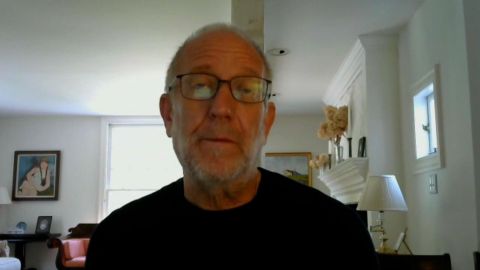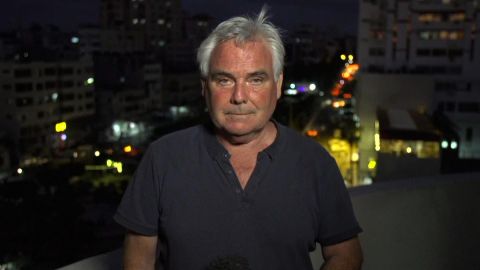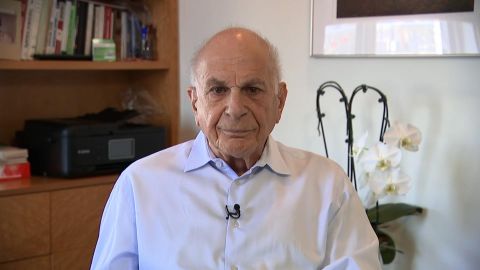Read Transcript EXPAND
BIANNA GOLODRYGA: Well, now, to the new stage of the U.S. battle against the coronavirus. Last week, the CDC stunned the country announcing that
fully vaccinated people could ditch face masks. It’s something that left a lot of Americans feeling uneasy. But our next guest, a professor in
medical, Dr. Monica Gandhi, explains why there is no reason to panic. Here she is digging into her science with our Hari Sreenivasan.
(BEGIN VIDEO CLIP)
HARI SREENIVASAN: Bianna, thanks. Dr. Gandhi, thanks for joining us.
You know, you have been one of the proponents of mask wearing for the bulk of this pandemic. If anybody follows your Twitter feed, they know that you
amplified the research on this, you talk about this. And now, you had recent op-ed in “The Washington Post” that said, you know what, people who
are vaccinated don’t need it. How come?
MONICA GANDHI, PROFESSOR OF MEDICINE, UCSH/SAN FRANCISCO GENERAL HOSPITAL: You know, it may not have been messaged that well in the press briefing.
But really, that knowledge that we don’t need mask after mass vaccination is based on a number of real-world effectiveness studies that came out
since the clinical trials about how well the vaccines work.
I think the vaccine clinical trials is so very December 2020 because right now, we have study after study that shows how incredibly effective these
vaccines are in the real-world. Some of the studies cited in the guidance were a May 6th publication from JAMA, from health care workers in Israel
that showed an effectiveness of 97 percent.
A study in Qatar, from The New England Journal, even despite variants, the effectiveness of these vaccines are unfazed at about 98 percent. And then
studies from the CDC in older individuals, that even when you’re older, your immune response works really well and hospitalizations were completely
prevented by 95 percent.
So, a lot of — and that was despite circulating virus. So, a lot of incredible real-world effectiveness, they also cited something really
important in this step, we keep track of breakthrough infections. And there’s very rare that you get ill from breakthrough infections after
you’ve been vaccinated, one in a million.
So, it’s that effectiveness plus all the data blocking transmission that the vaccines do. I always thought biologically that happened actually, but
again, study after study, they cited about three that shows promise (ph) in getting even asymptomatic infection in your nose. And if you have very
little virus in your nose, you can’t pass it onto others. We haven’t seen effectively too much transmission after vaccination.
So, putting all that data together, it sounds that a vaccinated person doesn’t have to wear masks inside or out. But, you know, it was abrupt.
SREENIVASAN: Yes. That abruptness, let’s talk a little bit about that. I mean, it seems the messaging has been the challenge here because so many
people have been clinging to the words of what the CDC suggests. And yet, when they said, vaccinated people don’t have to wear masks, there was still
a lot of fear. I mean, it is — I walk around in my neighborhood here and say 90 percent plus are masked.
GANDHI: Yes. I mean, I think there are two reasons for that. One that we didn’t do — I think people are doing a good job all along by saying how
well things were going. So, that it suddenly seemed like a reverse — like a complete about face.
So, starting from April 14th, when the country in the U.S. hit a 40 percent first vaccination rate, cases started plummeting. And I mean, Michigan,
Minnesota, everywhere. Places that were giving us fear as we were rolling out the vaccines and cases were still going up. Everything went down.
Hospitalizations actually were reducing before April 14th and subsequently deaths because these vaccines were being given out to older individuals
first. And because of that, they were more likely to get sick.
So, severe illness had already decreased, April 14th cases started plummeting. We are at the lowest case rate that we’ve ever been, below
30,000 across the entire country. And if that had been messaged more effectively before coming out, hey, we’re doing great. Keep on going.
This is really incredible, what cases and hospitalizations and desks are doing, let’s get to the point where we can really feel confident. Instead,
what happened is there was like, this is really scary. Do your part to stop the spread. We are not out of the woods yet. This is super, you know,
concerning. Many Americans have not been vaccinated.
And then suddenly, May 13th, hey, we are doing great and you can take off your mask. It was abrupt. That’s a messaging problem. That actually has
nothing to do with science. That’s how we communicate in public health.
And then the second reason is, frankly, mask wearing became linked with a political identity which has nothing to do with its biological purpose.
SREENIVASAN: Is there any harm here in wearing masks for the foresee foreseeable future? Is there sort of an unintended consequence?
GANDHI: My concern about harm is that it messages, if a lot of people are still wearing masks after vaccination and the cases are very low. It
messages an abnormality. It messages that we’re not back to normal. It messages that we didn’t have this incredible fortune of having these
vaccines in this rich country that got our cases so low. And it messages that there is danger.
And I’m concerned that that message that there’s still danger can lead to schools being abnormal in the fall for our children who have, frankly, the
risk — much lower risk for severe disease, but they have been out of school because of more concerns for adults over the last year. So, I’m
concerned that that message is fear that can make parents fearful.
The second thing is that actually the best thing we can do for any virus that causes symptoms, and that’s why you’re sick, which is influenza and
colds, is stay home when you feel unwell. How many of us have gone to work when we don’t feel well before the COVID-19 pandemic? That’s the — it’s
called syndromic surveillance, but that’s the best way to prevent an infection that’s symptomatic from spreading.
And then the third is, there are mental health effects of the mask in the sense that it’s — I think we are looking forward to seeing faces.
President Biden said, we’re going to see each other’s smile again. I thought that was really moving when he said that on May 13th when he
messaged the guidance after the White House task force guidance. There is something to be said for seeing each other.
And then the fourth reason is actually — I know it’s really hard to remember this now, but we actually need some exposure to pathogens for our
microbiome. There’s the NIH Microbiome Project. And the more — you do need a little mild exposure to pathogens to keep your microbiome healthy and
activated.
SREENIVASAN: You know, one of the things that was different about how this message came out was, for so long during this pandemic, we were taught to
think about our particular communities and the spread of the virus or even the vaccination rates, but this was just kind of a blanket guidance, right?
So, what you are experiencing in California might be very different from what I’m experience here. But yet, the guidance is national.
GANDHI: Yes. I think this is a great point. So, prior to the CDC releasing this new guidance, my idea — and I actually wrote a lot of people with
this idea, is that it would be more based on case rates in your community when you lifted masks for everybody. So that the how to — it’s really a
simple way to think of it. The vaccinated are protected by their vaccine status. And the unvaccinated, like children, are protected by low case
rates in the community like it was 2019.
So, right now, in the City of San Francisco, there are so few cases of COVID of children who are unvaccinated, they are protected by the community
case rate. But — and so, there could have been a way to link those two metrics together, vaccination rate plus low case rates and a lift for
everybody. And instead, it was distinguishing vaccination rates as if community incidents didn’t matter and that confused a lot of people as
well.
SREENIVASAN: Given the vaccination rates nationally where they are, is it likely that we will see another surge or, again, back down to the community
level of community, specifically somewhere in America only has a 20 percent or 30 percent vaccination rates. Is there a chance that there could be
another variant that sneaks in or whatever, another surge is likely there versus an area like where I’m at or maybe it’s above 50 percent that are
vaccinated has less of a chance?
GANDHI: I think that is a great question. So, I’ve been thinking of these things called inflection points and — or least, that’s what I call them. I
think some people call them tipping points. But it seems at 40 percent, if you didn’t have a lot of immunity in your population before, that would be
like Israel who didn’t have a lot of immunity but U.K. had more immunity. That would be like Michigan who didn’t have as much national immunity as
California.
At 40 percent, it seemed like cases started coming down. And then at 60 percent, first vaccination rate. And it’s really important to say first
vaccination rate because there’s the debate about, you know, if we could have made the extension more between first and second doses. It seems that
whatever you do at 60 percent first vaccination rate, it is hard to get cases to go up.
What do I mean by that? Liverpool — U.K. in Lliverpool, you know, had a nightclub of 3,000 people maskless and sweaty on a dance floor as an
experiment. It was on May 5th. And then they watched cases. Cases didn’t go up because they had passed that kind of magical first vaccination rate.
Actually, the U.S. passed that rate yesterday, 60 percent of Americans are first dose vaccinated.
But as you say, some areas are 43 percent and some areas are 80 percent. And like — well, close to 80 percent in San Francisco. So, that’s making
the average 60 percent. So, do I think we will have a surge in winter? I think it is only possible in places that stubbornly don’t get to that 60
percent first vaccination rate. And do I think there will be places like that?
Not if we message right. I mean, actually, I think the “New York Times” did a good job yesterday with a very judgmental title actually saying, these
are the people holding you back. But instead — regardless of the title, there was a really good example of what are the barriers to being
vaccinated?
And one was pure logistics. If your job won’t give you two hours off and you just lost pay, you’re not going to go and get your vaccine. You don’t
have time. So, logistics, compassion at messaging. We still have 1.5 million doses being given out in the United States a day. I think we’re
going to get to the 60 percent first dose.
SREENIVASAN: Recently, there were a few stories about several New York Yankees that had breakthrough infections. And depending on who you listen
to, people were scared that, oh, my gosh. They got this vaccine but here they are still getting COVID. And other people were positive saying, you
know what, they are not in the hospital, they’re not dead, which is the point of vaccines.
GANDHI: Yes. Actually, that was amazing because it sort of came out the same day as the CDC guidelines that you could take off your mask and that
cognitive desinence was difficult. So, I actually have another take on that that’s a little different from what you just said but it’s along the second
lines. So, eight members, I think there were staff as well of the team had COVID-19 in their nose, PCR testing and seven of the eight were
asymptomatic.
And they had been vaccinated with the Johnson and Johnson vaccine because it was kind of one and done. So, it was easy and then they could go back to
play. And two things. One is that what you just said is really important that having asymptomatic infection in your nose after vaccination if a very
different situation than before vaccination because before vaccination, the problem was that you could still have high viral loads in your nose and
spread it to others.
In fact, it was the Achilles’ heel of this virus, why it spread so fast. But you could feel well and still have high viral loads in your nose. There
are now four papers that show your virus in your nose, your viral load in your nose is so low, if you are asymptomatic after vaccination, that you
are unlikely to be able to spread it to other people based on that kind of PCR testing cycle thresholds, for example.
And so, those asymptomatic infections, I think, are actually the vaccines working in the sense that you have IgG, which is an antibody, IgA, which is
(INAUDIBLE) antibody, T cells in your nose that are all generated by the vaccine, they swoop in and they get that infection, they bring your viral
loads low. You stay well and you can’t transmit. So, I think that can be a success, which is why we are not asking people to test if they are
asymptomatic after vaccination in this country and why we’re tracking symptomatic breakthroughs but not asymptomatic breakthroughs.
Second reason though, I just want to add, is Johnson and Johnson, if you look back at the clinical trials, what we call the phase 1, 2 trials where
they were mentioning immune responses, this was in “The New England Journal” in December. Actually, the immune response did not reach its peak
until 60 days after you have gotten the first dose vaccine.
And between two and four weeks — at two weeks, it wasn’t great, but at four weeks, it was better. So, I actually advised people to not feel that
they are totally safe after Johnson and Johnson until four weeks after that shot, not two weeks.
SREENIVASAN: Speaking of letting people run around, this is the question on every parent’s mind right now, thinking about summer camps and thinking
about school in the fall, where are we at in understanding the risk to children of getting COVID, of them being hospitalized, of them transmitting
it to other children and what should parents be thinking about?
GANDHI: We wrote a commentary yesterday to two papers that were published in hospital pediatrics that showed that even when children got hospitalized
for COVID, you know, we do universal testing in hospitals. We swab everyone’s nose for an infection control, principle to help keep staff
safe. And these two papers from California Hospital showed that children were not being hospitalized at the rates we thought they were. Actually,
there’s actually a 40 percent overinflation.
Even in the low numbers of hospitalizations where children anyway, when they did careful chart review, it turns out children were just screened
incidentally, had it in their nose but they were in for a broken arm or something else. And so, 40 percent inflation in this children
hospitalization, which I know had made its way into the news that as if children were being more hospitalized for COVID over the last year, which
is not true.
So, number one, they’re low risk for severe disease. That is important. They don’t transmit as readily as they’re young. That is important and
true. It has to do with receptors in your nose, which is true. So, they’re less likely to transmit, even among households. And then third, is that
when we look to the summer — and then one more point, the summer is — you know, this outdoor transmission data, it’s not that it’s new, but really,
it’s very difficult to get COVID outside.
And, you know, there was quite a bit of argument about this a couple of weeks ago in Congress. But it’s very clear that about 1 in 1,000 of most
transmissions look like they occur outside, more like 1 in 7,000 in the best on a study at September 2020 “Lancet” article from Wuhan, China where
they really, really carefully tracked people, 7,324 infections. One linked to outside.
So, unmasking children outside in summer camps is actually completely unrelated to vaccination status. Many of them will the vaccine — have the
vaccine by then, but they can be unmasked outside during summer camp.
And then finally, when you said, what will the fall going to look like? It depends on the case rate. So, again, a child is protected if the community
transmission is low, which is why I think you have to link everything to case rates. And the U.K. was very smart about this. 3 in 100,000 cases a
day or 21 over a 7-day period, children are safe. Unmasked, undistanced in schools.
SREENIVASAN: So, when we think about this, are there these other mitigation strategies that we should continue with? I mean, when I walk
into a building now, there’s a little scanner for my temperature, there’s a hand sanitizer everywhere. I mean, obviously, keeping your hands clean
helps you not get the flu as well. But what are the things that we should be continuing to be vigilant about?
GANDHI: So, there have been 22 peer review studies on the lack of any utility of temperature screen. So, we have to get away from that. That’s
the entire point of the fact that you can be asymptomatic and still spread. So, that is truly a waste of resources. And I’m hopeful we will stop that.
Plexiglass shields, no utility. This really is a virus that tends to hang in the air and has to do more with that aerosol droplet debate that
plexiglass shields (INAUDIBLE) Harvard has done great work on this, no point.
And then, in terms of hand sanitizer. Great for colds. There’s actually only studies with rotavirus, which is gastrointestinal virus and
rhinovirus, which is a cold virus and then influenza virus that washing hands helps, but no utility for coronavirus. So — because it really is
very easily spread as a respiratory virus. It doesn’t hang on surfaces and give people virus that way. We could be shaking hands if we wanted. I know
that’s going to be hard to get back to, but we could shake hands and we don’t need all that hand sanitizer.
I’m actually worried about the implications for anti-microbial resistance to have that much hand sanitizer out there. So, those three could be
abandoned right now.
SREENIVASAN: Dr. Monica Gandhi from UCSF, thanks so much for joining us.
GANDHI: Thank you.
About This Episode EXPAND
Ben Wedeman; Yossi Klein Halevi; Mariam Barghouti; Daniel Kahneman; Dr. Monica Gandhi
LEARN MORE




